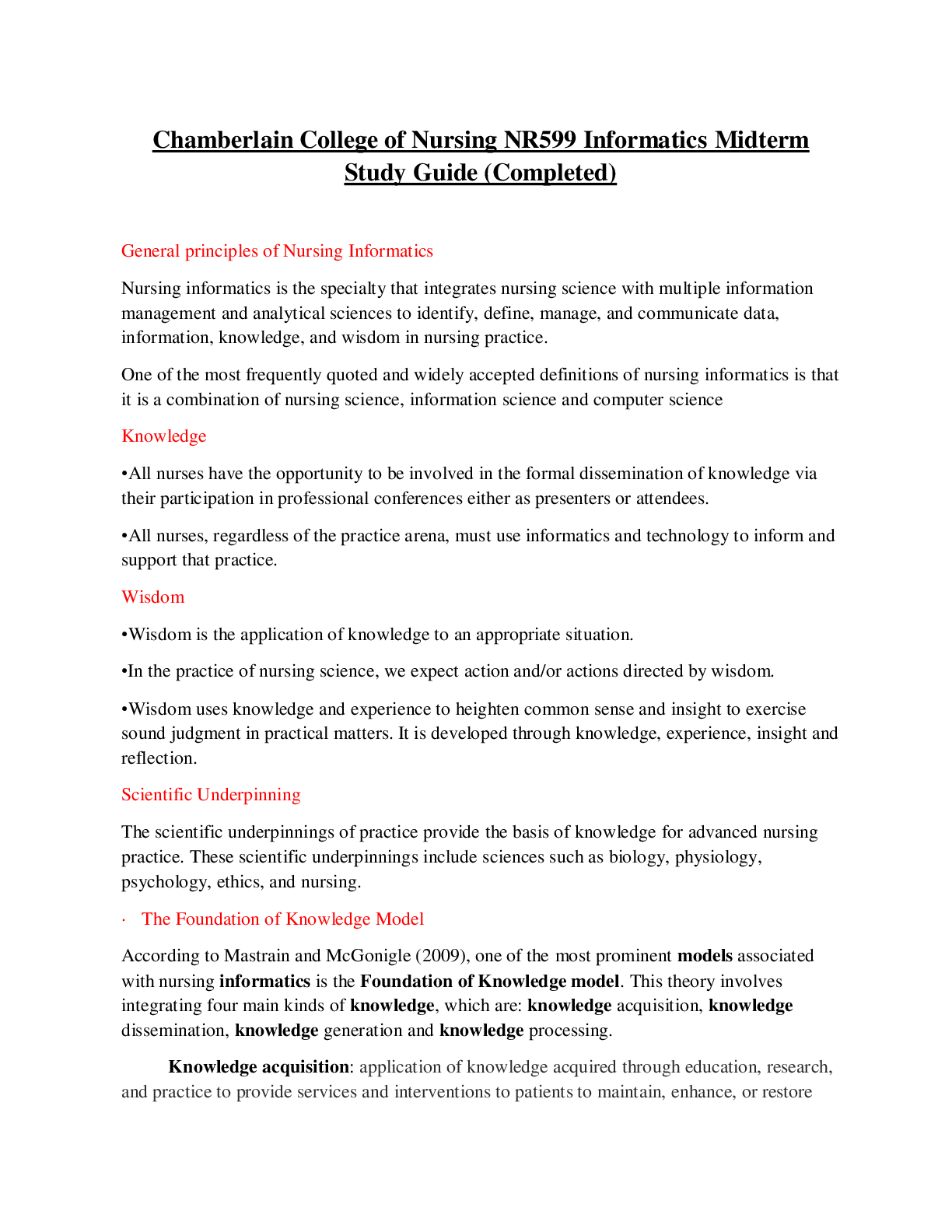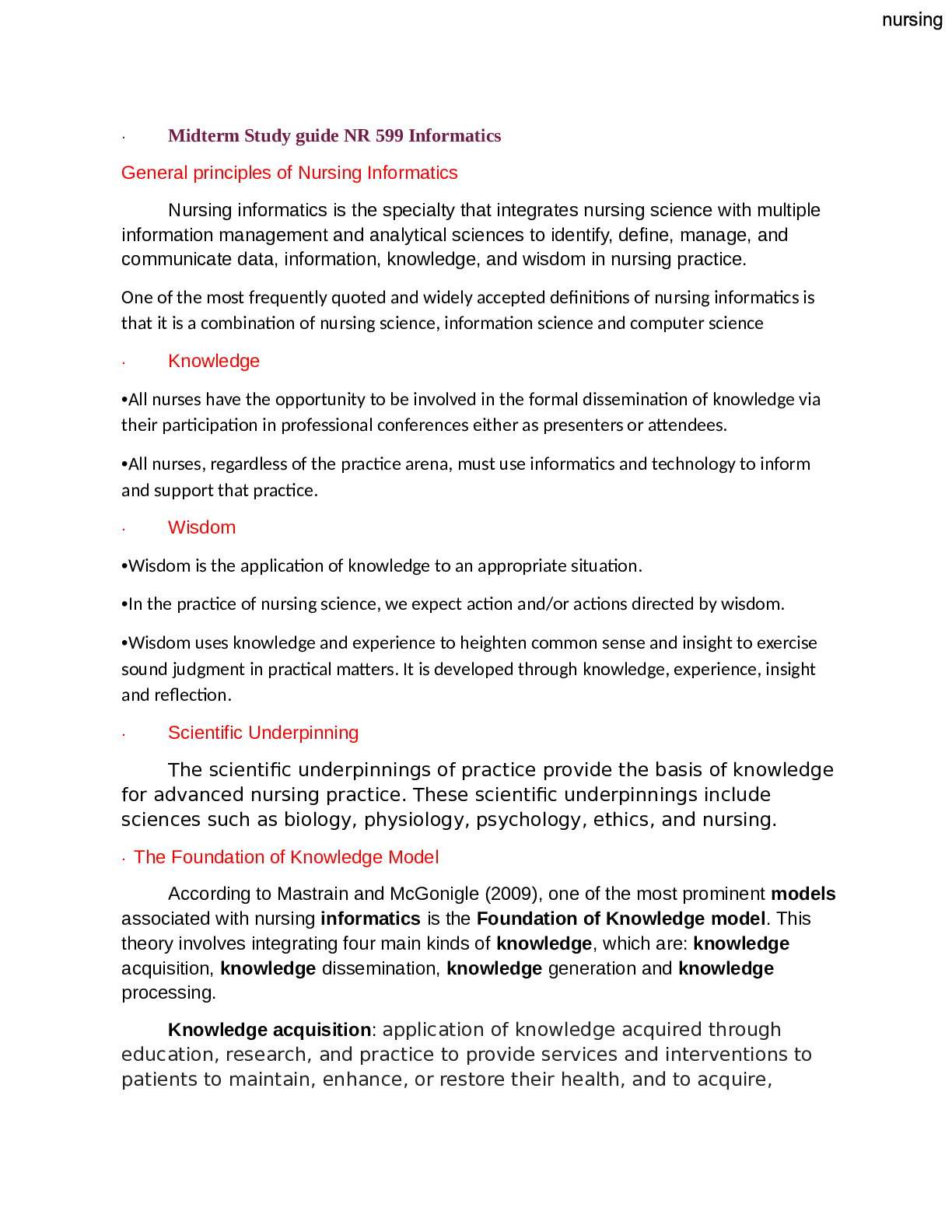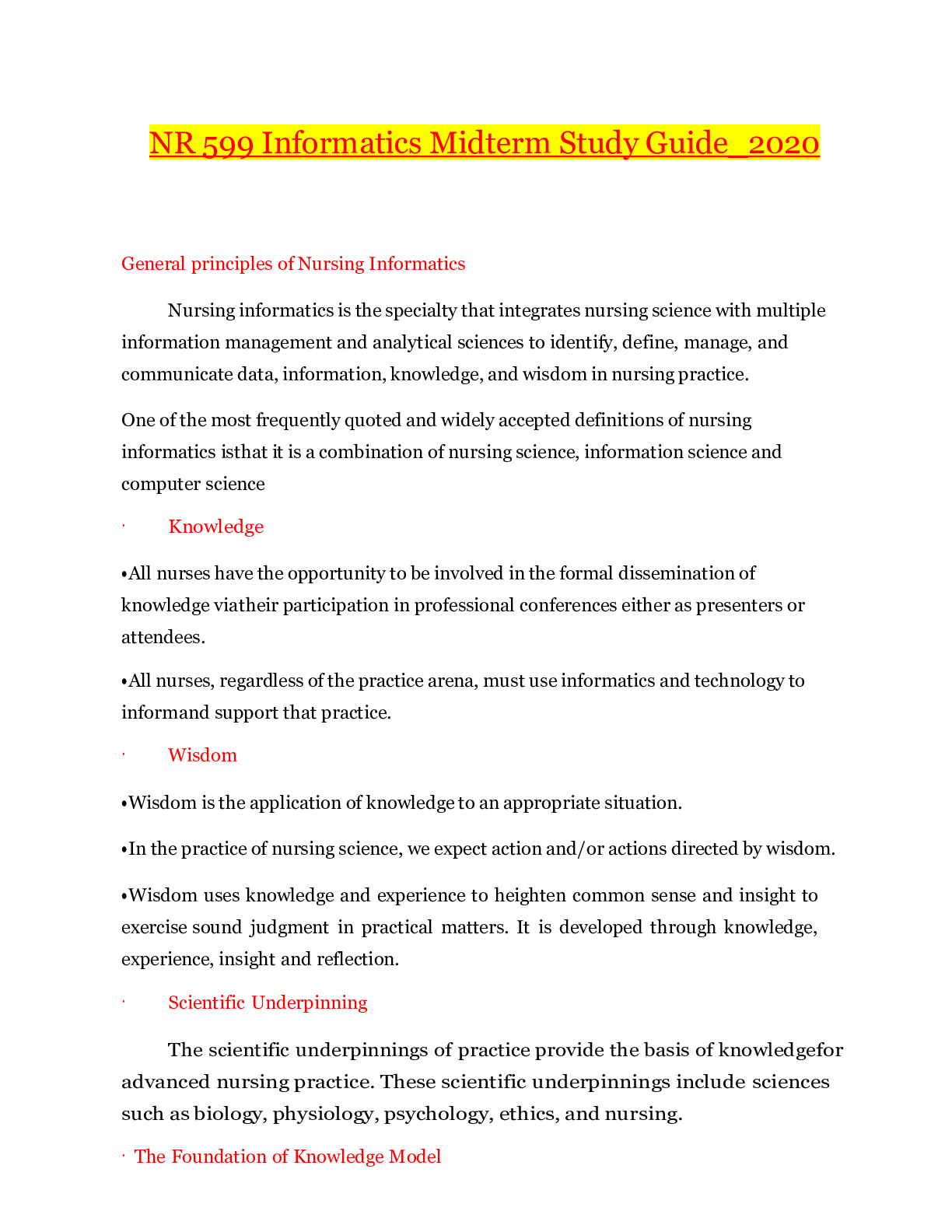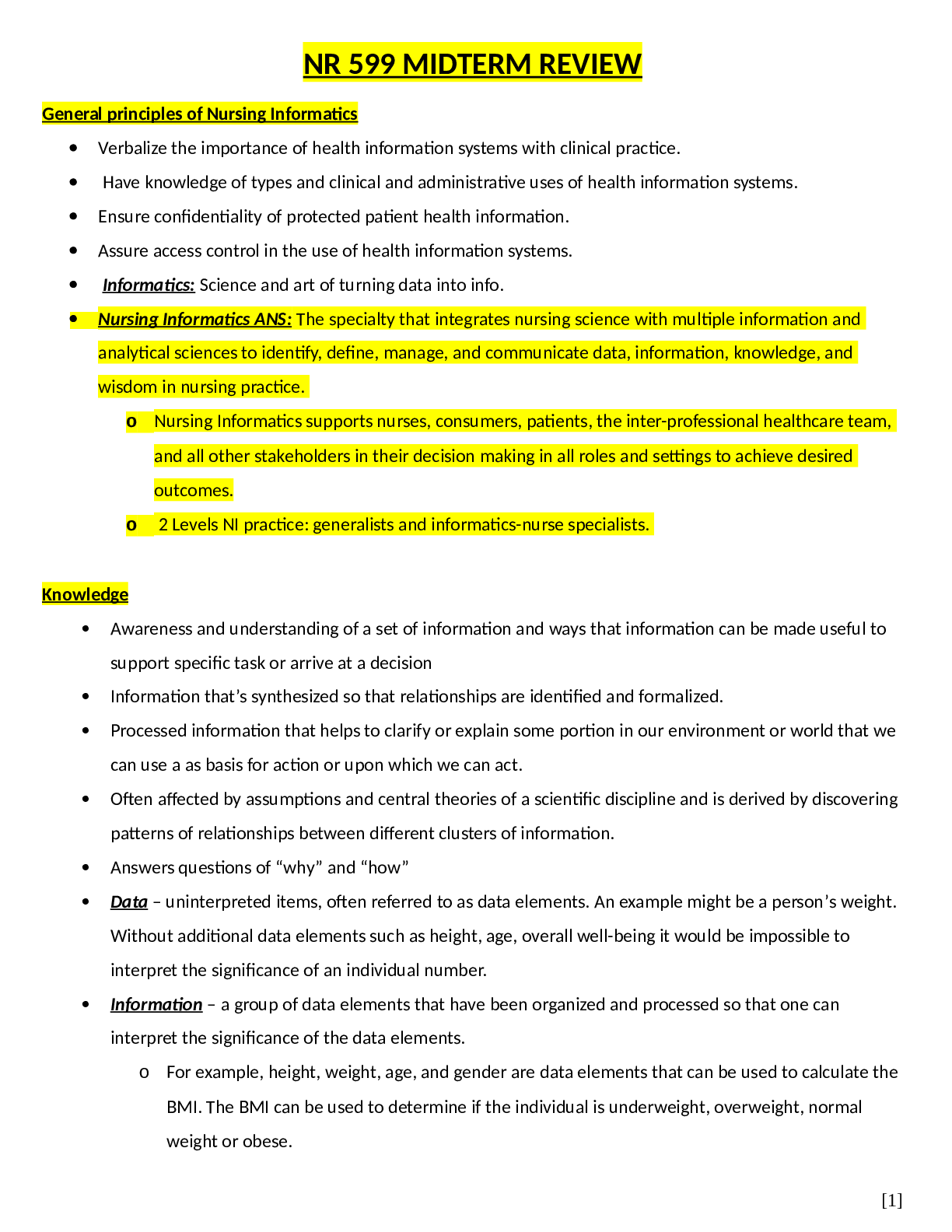*NURSING > STUDY GUIDE > NR 599| Informatics Midterm Study Guide-VERIFIED LATEST UPDATE (All)
NR 599| Informatics Midterm Study Guide-VERIFIED LATEST UPDATE
Document Content and Description Below
Midterm SG 1. General principles of Nursing Informatics o Informatics: Turns data into information Focuses on HIT & involves computer, cognitive and social sciences Science of how to use d... ata, information and knowledge to improve human health & delivery NI: specialty integrating nursing science, computer science, information science and cognitive science to manage and communicate data, information, knowledge, and wisdom in nursing practice. Building blocks of NI: Nursing, information, computer and cognitive science 2. Knowledge o Information is a key building block of knowledge o Awareness and understanding of a set of information and ways that information can be made useful to support a specific task or arrive at a decision o Information that is synthesized so that relationships are identified and formed o Information that has judgment applied to it or meaning extracted from it o Processed information that helps to clarify or explain some portion of our environment or world that we can use as a basis for action or upon which we can act. o Internal process of thinking (cognition) o External process of testing, sense, observation, and interacting Knowledge that is patterned for use in reasoning is known as knowledge representation o Epistemology: study of the nature and origin of knowledge (what it means 2 know) o Sources of knowledge: instinct, reason and intuition 3. Wisdom o “Foundation of the art of nursing” o “Highest form of common sense” result from accumulated knowledge or deep learning (erudition) or enlightenment o Application of knowledge to an appropriate situation. o Actions are directed by wisdom o Uses knowledge and experience to heighten common sense and insight to exercise sound judgment in practical matters o Its developed through knowledge, experience, insight, and reflection. o Transparent wisdom: applying knowledge in a practical way or translating knowledge into actions without conscious thought Knowledge abounds with others’ thoughts and information, whereas wisdom is focused on one’s own mind and the synthesis of experience, insight, understanding, and knowledge. 4. The Foundation of Knowledge Model Base: bits, bytes (quantify data) data and information ADGP Cones: aspects of knowledge 1. Knowledge Acquisition: the act of getting knowledge 2. Knowledge Dissemination: distribution and sharing of knowledge 3. Knowledge Generation: The creation of new knowledge by changing and evolving knowledge based on one’s experience, education, and input from others. 4. Knowledge Processing: (where A, D & G intersect) The activity or process of gathering or collecting, perceiving, analyzing, synthesizing, saving or storing, manipulating, conveying, and transmitting knowledge. Feedback: cut through & may transform all aspects of knowledge (cones). ADGP & feedback are constantly evolving This study source was downloaded by 100000831988016 from CourseHero.com on 04-25-2022 01:29:06 GMT -05:00 https://www.coursehero.com/file/54567420/Midterm-SGdocx/ 5. Scientific Underpinning o Cognitive science o DIKW paradigm (data, info, knowledge, wisdom) 6. Computer science o Offers tools that if used right, can facilitate acquisition and manipulation of data and information by nurses, who can then synthesize these into evolving knowledge and wisdom base. o Can facilitate professional development and the ability to apply evidence-based practice decisions within nursing care, and if the results are disseminated and shared, can also advance the professional knowledge base. 7. Cognitive science o Studies the mind, intelligence, and behavior from an information-processing perspective 8. Information science o Information is data made functional through the application of knowledge o Information is valuable if: accessible, accurate, timely, complete, cost-effective, flexible, reliable, relevant, simple, verifiable, and secure o Data is converted to information (& new knowledge) when previous knowledge is applied to data. o 9. Standard Terminology o 10. Informatics Competencies o NI competency o Three categories: computer skills, informatics knowledge, and informatics skills 11.Information literacy o Framework for finding, understanding, evaluating and using information 12. Health literacy o The degree to which individuals have the capacity to obtain, process, and understand basic health information and services needed to make appropriate health decision This study source was downloaded by 100000831988016 from CourseHero.com on 04-25-2022 01:29:06 GMT -05:00 https://www.coursehero.com/file/54567420/Midterm-SGdocx/ o 13. Meaningful Use (MU) o Rules and regulations established by the ARRA (American recovery and reinvestment act) o Healthcare organizations can qualify for financial incentives based on the level of MU o The ARRA of 2009 specifies three main components of meaningful use: (1) the use of a certified electronic health record (EHR) in a meaningful manner, such as eprescribing; (2) the use of certified EHR technology for electronic exchange of health information to improve quality of health care; and (3) the use of certified EHR technology to submit clinical quality and other measures. o The criteria for meaningful use will be staged in three steps. Stage 1 (2011–2012) set the baseline for electronic data capture and information sharing. Stage 2 (2014) Stage 3 (launched in 2017/2017) continue to expand on this baseline and be developed through future rule making. o The goal of meaningful use is to exchange clinical structured data in a manner that is accurate and complete to improve patient care in a cost-efficient way. 14. Patient-centered Information Systems o Patient-centered information systems focused on collecting data and disseminating information related to direct care. Several of these systems have become mainstream types of systems used in health care. The four types of systems most commonly found in healthcare organizations include (1) clinical documentation systems, (2) pharmacy information systems, (3) laboratory information systems, and (4) radiology information systems. 15. Clinical Decision Support Systems o A computer-based program designed to assist clinicians in making clinical decisions by filtering or integrating vast amounts of information and providing suggestions for clinical intervention. May also be called a clinical decision support system (CDSS). 16. Electronic Medical Records o Computer-based data warehouses or repositories of information regarding the health status of a client, which are replacing the former paper-based medical records; they are the systematic documentation of a client’s health status and health care in a secured digital format, meaning that they can be processed, stored, transmitted, and accessed by authorized interdisciplinary professionals for the purpose of supporting efficient, high-quality health care across the client’s healthcare continuum. Also known as electronic medical records (EMRs). This study source was downloaded by 100000831988016 from CourseHero.com on 04-25-2022 01:29:06 GMT -05:00 https://www.coursehero.com/file/54567420/Midterm-SGdocx/ 17. Human-Technology Interface o The hardware and software through which the user interacts with any technology (e.g., computers, patient monitors, telephone). 18. Health Information Technology (HIT) 19. Alarm fatigue o Multiple false alarms by smart technology that cause workers to ignore or respond slowly to them. 20. Digital natives 21. Information Literacy Competency Standards for Nursing 22. HITECH Act 23. TIGER-based Nursing Informatics Competencies Model o Tiger initiative: the work of the technology informatics guiding education reform team. This team of nurse leaders developed a vision for utilizing information technology to transform nursing practice Focus of Nursing Human responses to actual or potential health problems and advocacy for various clients Nursing Science The ethical application of knowledge acquired through education, research, and practice to provide services and interventions to patients so as to maintain, enhance, or restore their health; to advocate for health; and to acquire, process, generate, and disseminate nursing knowledge to advance the nursing profession. Borrowed theories Theories borrowed or made use of from other disciplines. As nursing began to evolve, theories from other disciplines (e.g., psychology, sociology) were adopted to try to empirically describe, explain, or predict nursing phenomena. As nursing theories continue to be developed, nurses are now questioning whether these borrowed theories were sufficient or satisfactory in their relation to the nursing phenomena they were used to describe, explain, or predict. Nursing theories Concepts, propositions, and definitions that represent a methodical viewpoint and provide a framework for organizing and standardizing nursing actions. Clinical database Collections of related patient records stored in a computer system using software that permits a person or program to query the data to extract needed patient information. Clinical practice guidelines Informal or formal rules or guiding principles that a healthcare provider uses when determining diagnostic tests and treatment strategies for individual patients. In the electronic health record, they are included in a variety of ways such as prompts, pop-ups, and text messages. Relational database A database that can store and retrieve data very rapidly. “Relational” refers to how the data are stored in the database and how they are organized. Data mining A process of utilizing software to sort through data so as to discover patterns and ascertain or establish relationships. This process may help to discover or uncover previously unidentified relationships among the data in a database. Computer science Branch of engineering (application of science) that studies the theoretical foundations of information and computation and their implementation and This study source was downloaded by 100000831988016 from CourseHero.com on 04-25-2022 01:29:06 GMT -05:00 https://www.coursehero.com/file/54567420/Midterm-SGdocx/ application in computer systems. The study of storage/memory, conversion and transformation, and transfer or transmission of information in machines— that is, computers—through both algorithms and practical implementation problems. Algorithms are detailed, unambiguous action sequences in the design, efficiency, and application of computer systems, whereas practical implementation problems deal with the software and hardware. practicing nurses could be classified into four categories: (1) beginning nurse, (2) experienced nurse, (3) informatics nurse specialist , and (4) informatics innovator . This study source was downloaded by 100000831988016 from CourseHero.com on 04-25-2022 01:29:06 GMT -05:00 https://www.coursehero.com/file/54567420/Midterm-SGdocx/ This study source was downloaded by 100000831988016 from [Show More]
Last updated: 1 year ago
Preview 1 out of 6 pages
Instant download

Buy this document to get the full access instantly
Instant Download Access after purchase
Add to cartInstant download
Reviews( 0 )
Document information
Connected school, study & course
About the document
Uploaded On
Apr 25, 2022
Number of pages
6
Written in
Additional information
This document has been written for:
Uploaded
Apr 25, 2022
Downloads
0
Views
93



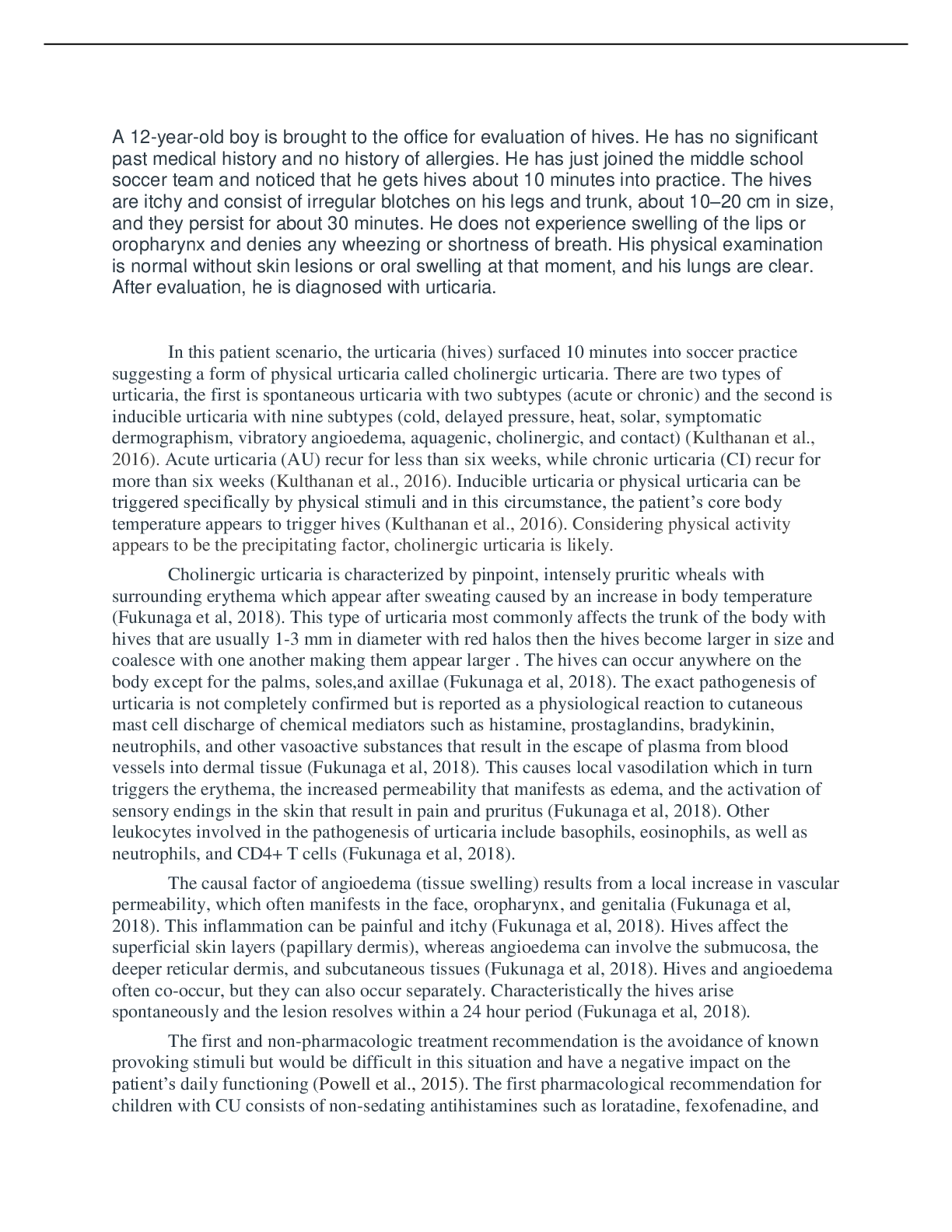
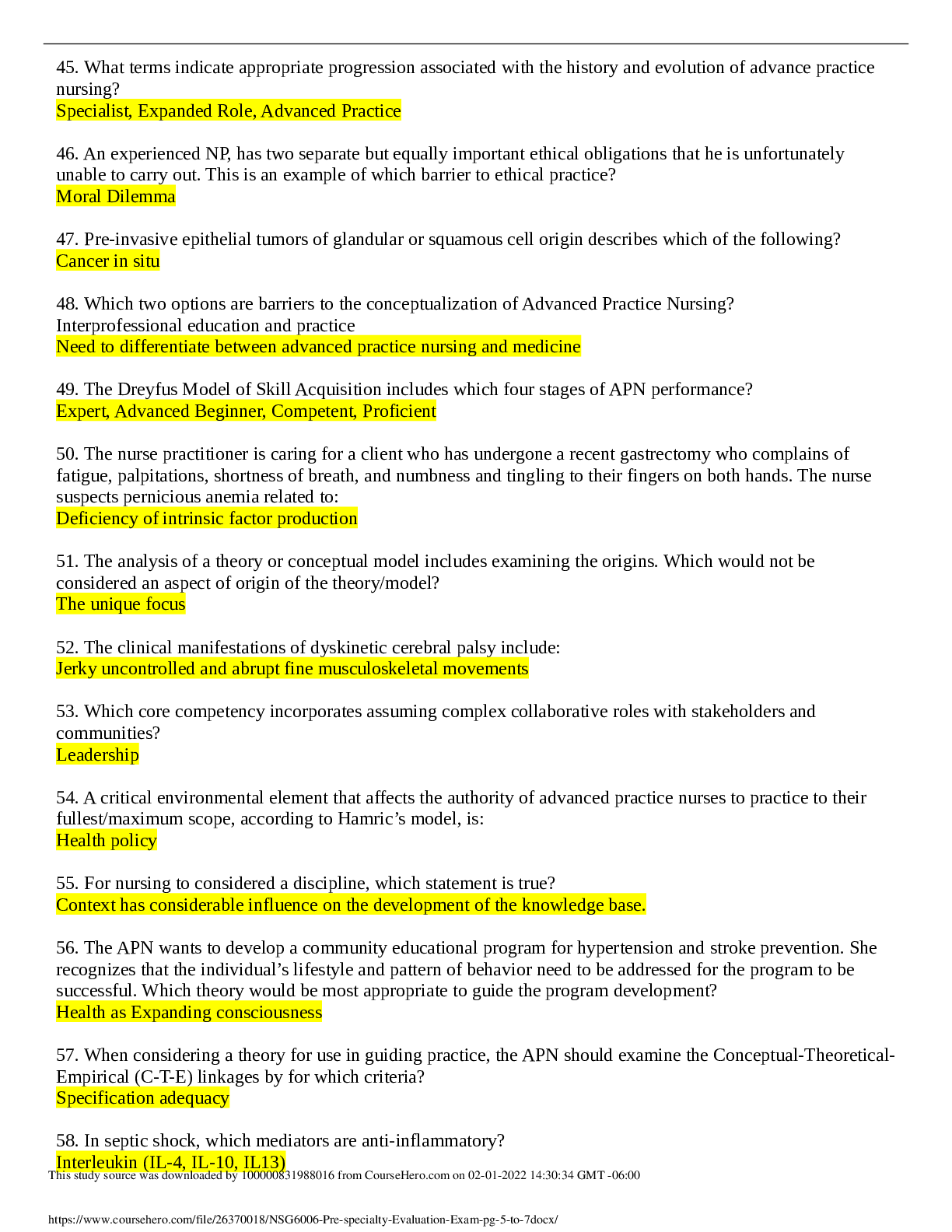





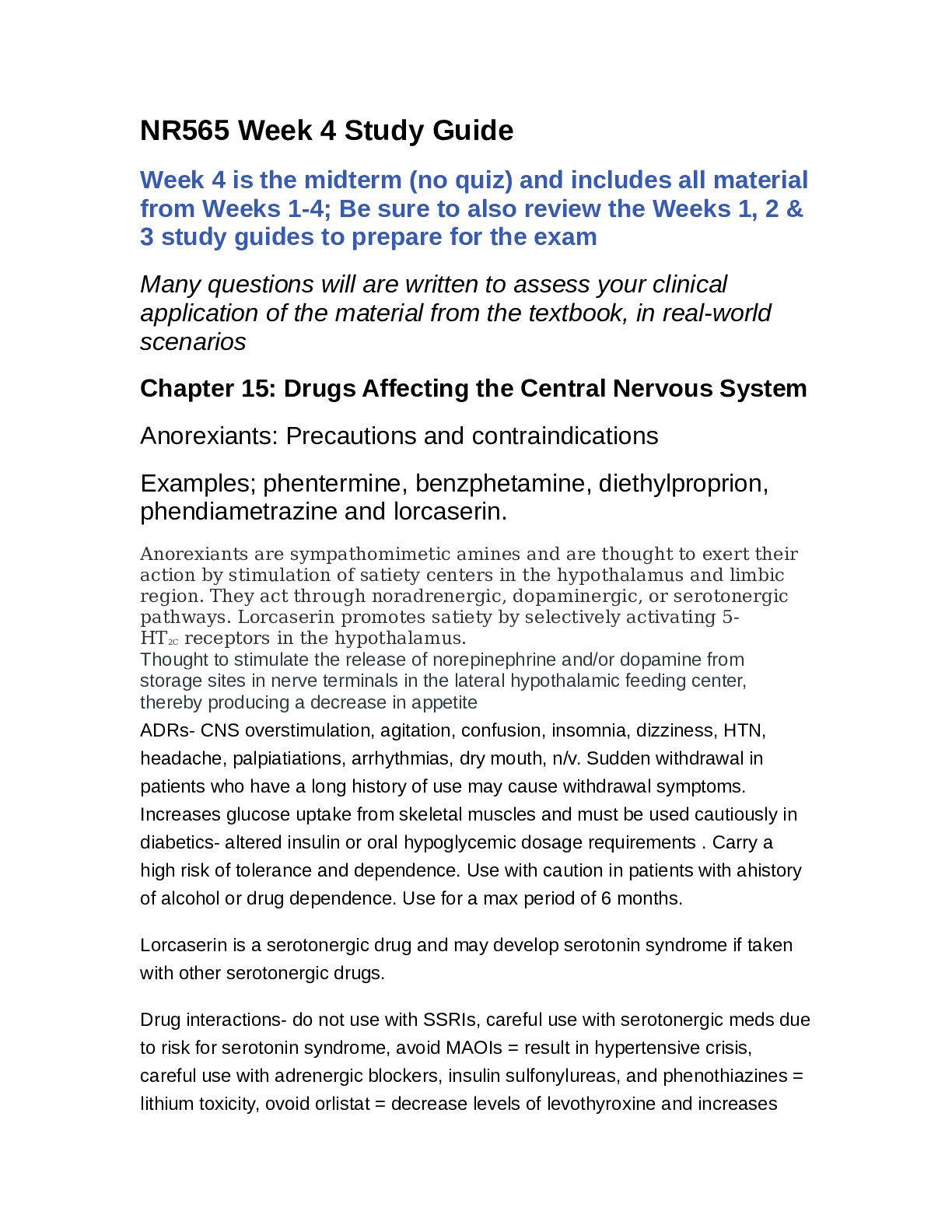


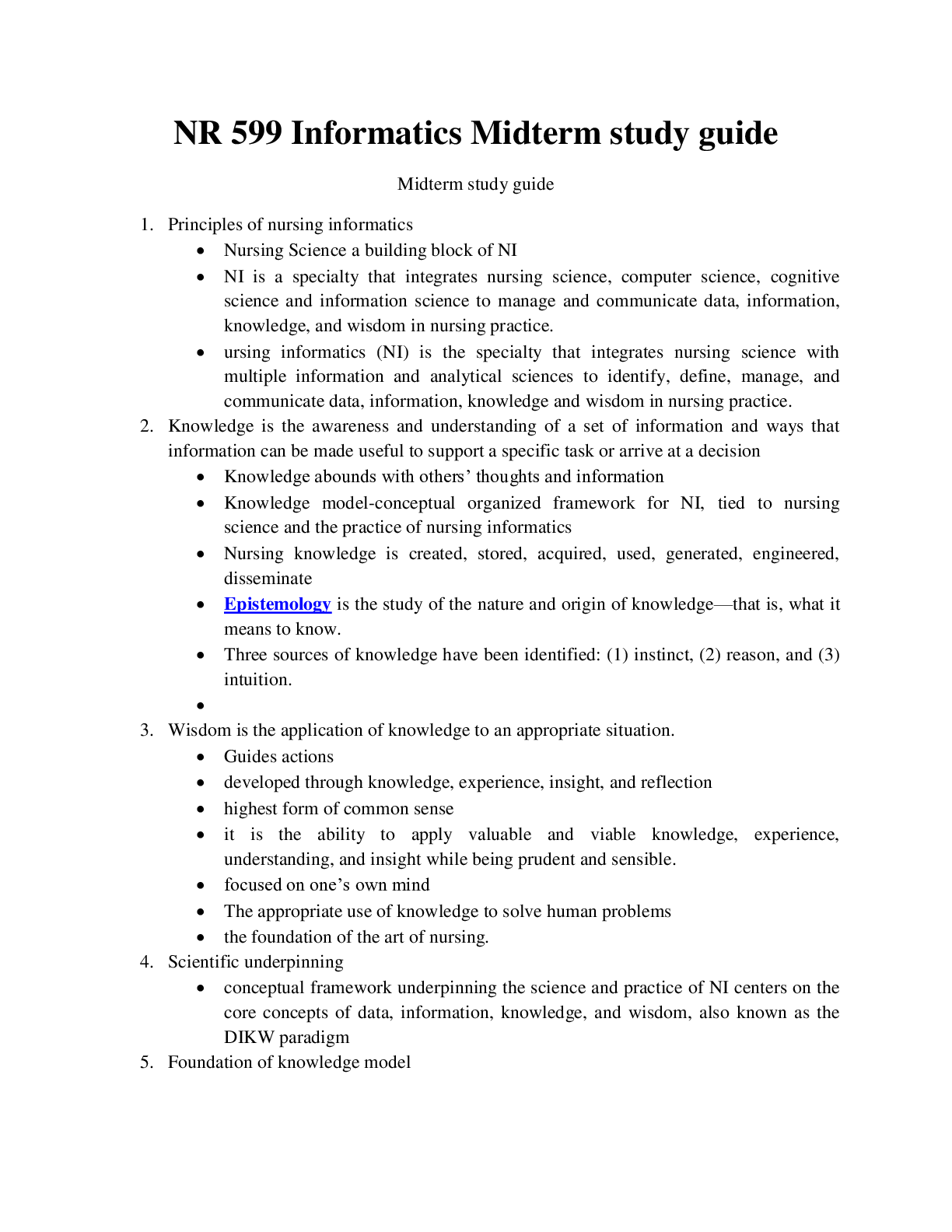

.png)
